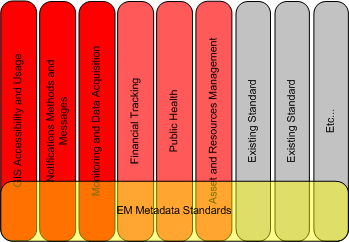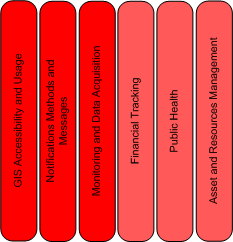From: http://www.oasis-open.org/committees/download.php/1391/2003.03.25%20-%20EM.Requirements.zip
Emergency Management Technical Committee
Requirements
Working Draft: 25 March 2003
- Abstract:
- This document specifies the formal Requirements for the Emergency Management Technical Committee for the creation of incident and emergency related standards.
- Status:
- This document is a Working Draft. If you have comments about this document, please send them to the Editor.
- Editor:
- R. Allen Wyke (emtc@nc.rr.com)
Copyright © 2002 The Organization for the Advancement of Structured Information Standards (OASIS)
Table of Contents
Terminology
For the purposes of clarity, we offer the following definitions for terms which may appear in, but are not specific to, this document.
- Emergency
- A serious situation or occurrence, generally one that happens unexpectedly, demands immediate action, and has implications beyond a single system.
- EM
- Emergency Management.
- EM TC
- Emergency Management Technical Committee.
- Event
- As defined by Dictionary.com, "A significant occurrence or happening."
- Incident
- An incident is a related series of events.
- MUST, MUST NOTE, REQUIRED, SHALL, SHALL NOT, SHOULD, SHOULD NOT, RECOMMENDED, MAY, and OPTIONAL
- Interpreted as described in RFC 2119.
- TC
- Technical Committee, as defined by OASIS.
Existing Standards
In order to help ensure the efforts of the EM TC
- are not overlapping any existing work in a negative way,
- minimize implementation costs, and
- include proper liaisons with other standards groups and bodies
the group will or has researched, reviewed, and performed any necessary contacts with the following efforts. Additionally, the TC has reviewed several recognized and important development methodologies and standards to help guide our overall process.
Specific Standards
The following is a list of specific standards.
- Abstract Syntax Notation number One (ASN.1)
- APCO Project 36 (Project InterCAD)
- Automatic Crash Notification (ACN)
- Common Alert Protocol (CAP)
- Incident Object Description and Exchange Format (IODEF)
- Intrusion Detection Exchange Format (IDMEF)
- OpenSec Advisory and Notification Markup Language (ANML)
OASIS Technical Committees
The following is a list of specific Technical Committees within OASIS the EM TC will communicate and potentially collaborate with.
- Content Assembly Mechanism (CAM) TC
- e-Government TC
- LegalXML (made up of multiple subcommittees)
- eXtensible Access Control Markup Language (XACML) TC
- Universal Business Language (UBL) TC
- XML Common Biometric Format (XCBF) TC
- XML Localization Interchange File Format (XLIFF) TC
Other Standards Bodies/Groups
The following is a list of specific standards bodies.
- Global Justice Information Sharing Initiative (Global)
- Homeland Security Standards Panel (HSSP)
- Incident Management Working Group (IMWG)
- Localization Industry Standards Association (LISA)
- Open GIS Consortium (OGC)
- Global Justice Information Sharing Initiative including the Justice XML Structure Task Force
Requirements
The driving purpose of this document is to list the requirements of the EM TC in order to further define and focus our efforts, the relationship we have to other work, and to provide a vision for our overall direction. While these items may evolve over time, they represent the founding principles of our focus. The requirements, themselves, are as follows:
Areas of Focus
While the scope of what and how incident and emergency components can be applied for interoperability is broad, the efforts of the EM TC was initially focused on several specific areas, which were mentioned in the original Call for Participation. As we begin the process of creating these standards, we have further focused our initial efforts in the following areas, including capability with appropriate operational structures such as NIMS, ESF, and ICS:
- Emergency GIS data accessibility and usage
- Notifications methods and messages
- Infrastructure
In addition to these initial areas of focus, the EM TC has also identified the following as a priority:
- Asset and resources management
- Areas around financial tracking
- Areas around public health
Modularity
The efforts of the EM TC SHALL conceptually be organized into the following two initiatives:
- EM Core Standards: target specific focus areas.
- EM Metadata Standards: can be applied to the Core Standards or any other emergency or incident related standards.
All created schemata SHALL be considered designed in a way to represent modules and will collectively create an incident and emergency data interoperability framework. All EM Core Standards modules MUST be interoperable with each other, and the EM Metadata Standards MUST interoperate with other designated standards. Visually, this is represented in Figure 1.

Figure 1: EM Core and Metadata Standards framework
EM Core Standards
When reviewing existing standards and groups, the EM TC discovered many standards efforts already adopted and/or underway. In order to best leverage the existing work of these groups, any current implementation investments, and to avoid duplication of work and confusion, the EM TC will only focus on gaps that are present. The purpose of the EM Core Standards is to address these emergency and incident standards gaps.
As shown in Figure 2, the end result of this process will be the creation of new standards in an interoperable way with each other, and existing standards.
EM Metadata Standards
During the initial research period performed by the EM TC, the need for a common semantical interoperability standard for incidents and emergencies was identified. Unlike the EM Core Standards, the EM Metadata Standards will take a cross-standard approach. In other words, each of the existing standards were created to fill a specific need and offered no interoperability between them. By creating EM Metadata Standards we will supplement these existing standards, as well as the EM Core Standards, with information to facilitate interoperability between multiple areas of concentration.
The purpose of the EM Metadata Standards is to provide these key semantical attributes to existing standards in a way that does not prohibit them from functioning as is, but rather to add additional information, in a non-obtrusive way, to allow for greater interoperability between the standards and the systems that have implemented them. As shown back in Figure 1, the end result of applying the EM Metadata Standards to the EM Core Standards and other standards, is an operationally transparent data layer that is available, if needed, to help apply consistent context to incident and emergency data.
Process
The EM Core and EM Metadata Standards SHALL be produced in accordance with OASIS principles and policies with regard to open, public standards processes, and intellectual property rights. Additional information about these processes can be found here:
In addition to the OASIS process, the EM TC has also reviewed and been influenced by several other recognized and important development methodologies, standards, and bodies. This was done in an effort to help guide and improve our overall standards development process to ensure success. These include the following:
- Federal Information Processing Standards (FIPS) at NIST
- Homeland Security Presidential Directive 5 (HSPD-5)
- ISO 11179
- MIL-STD-498
- Efforts from the Accredited Standards Committee (ASC) X12
The OASIS EM TC reserves the right to require further restrictions upon the use of its recommended specifications for the purpose of proprietary licensing of applications including such specifications if said use in any way constrains further use of EM TC Specifications. Specifically, we wish to make it clear that an application which uses an EM TC Specification for any application with a modification that renders that or any unmodified specification obsolete or unusable in whole or in part SHOULD NOT be allowed.
When and where possible, feedback from developers, implementors, and users SHOULD be sought to improve the usability of all EM TC Specifications.
Compatibility
EM TC Specifications MUST conform to XML Schema Part 1: Structures and XML Schema Part 2: Datatypes syntax and rules. Additionally, EM TC Specifications SHOULD also leverage and/or be compatible with RDF, XHTML, SOAP, and WSDL.
Terseness SHOULD be sought. This is to be considered a guiding principle. By adopting this principle as a requirement at this level of commitment, the OASIS EM TC aims to ensure greater compatibility through a lack of unnecessary complexity.
Extensibility
The EM Core and EM Metadata Standards MUST be extensible.
